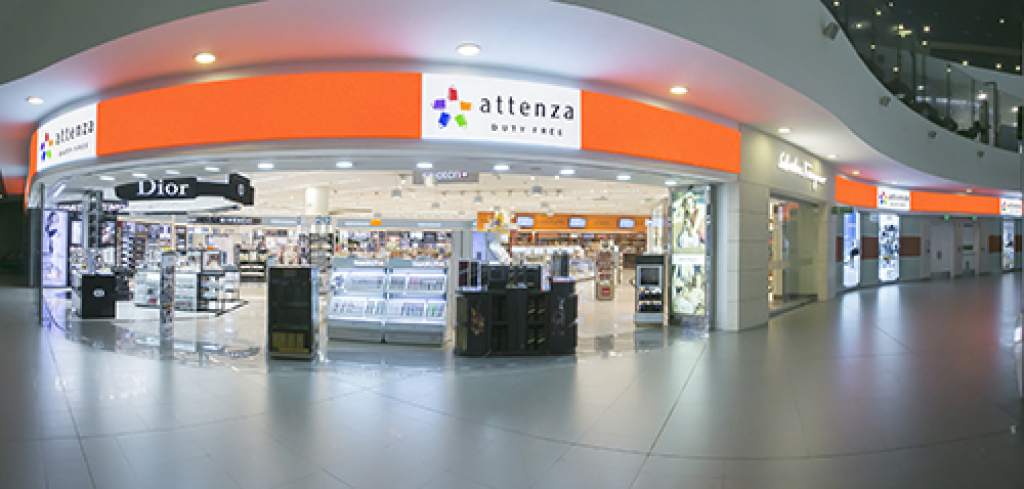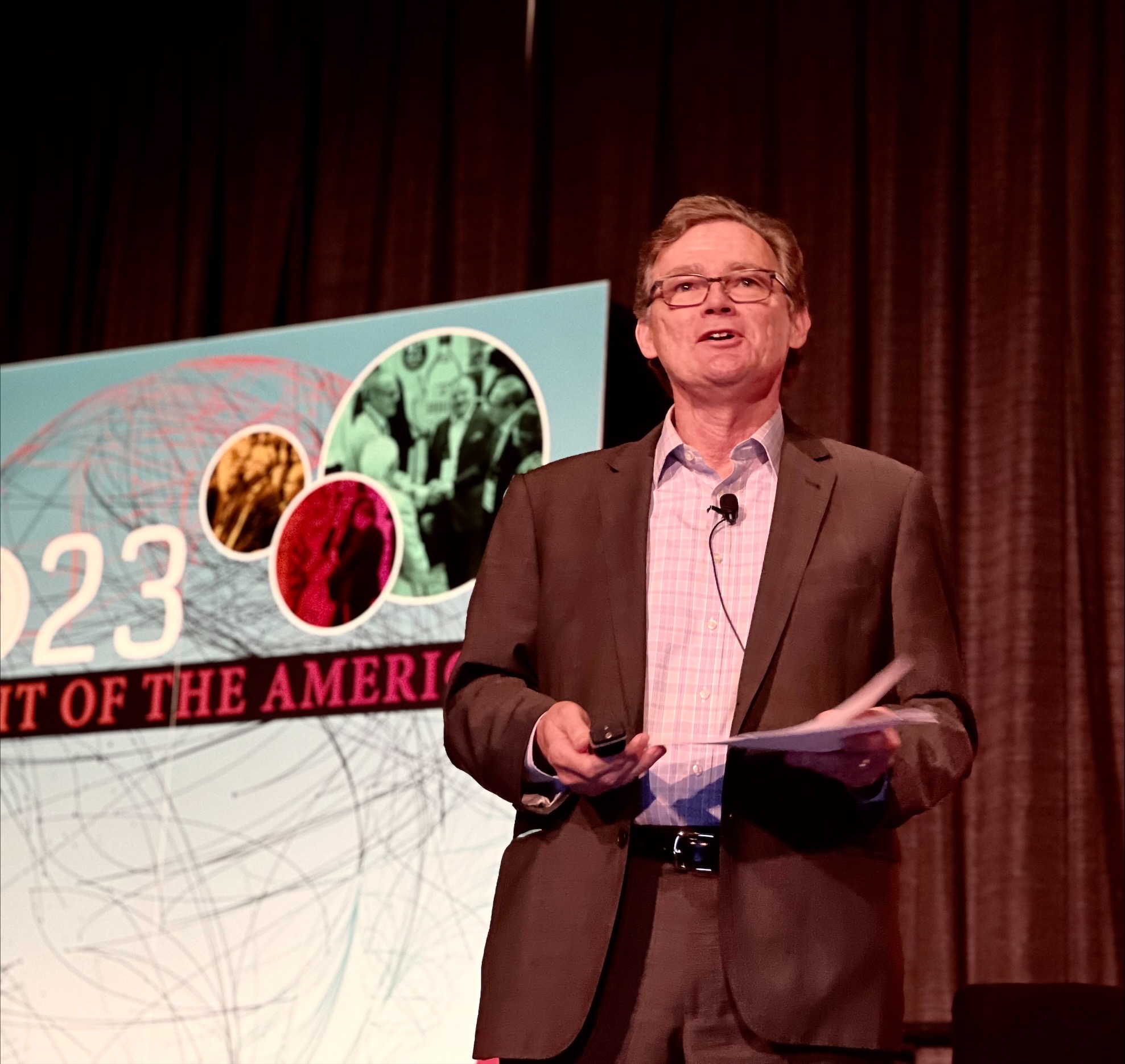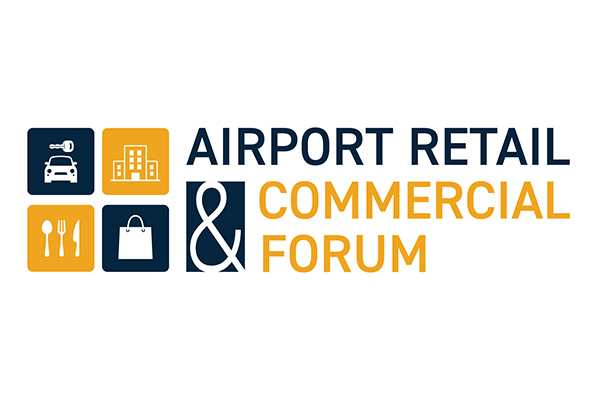AMERICAS. The changing landscape for airport concessions in the Americas was the theme of a key session – co-organised by The Moodie Davitt Report and the Airport Restaurant & Retail Association – at the recent IAADFS Summit of the Americas in Palm Beach.
It built on a panel discussion at the same event last year, in which we assessed how a ‘new normal’ for airport concessions might take shape.
Contributing to the session were International Shoppes Co-CEO Matthew Greenbaum, Motta Internacional CEO Erasmo Orillac, AirProjects Assistant Director and consultant Jim DeCock and ARRA Executive Director Andrew Weddig, alongside moderator Dermot Davitt, President of The Moodie Davitt Report.
Moving the conversation forward last month, we spoke about where the industry community is on the recovery curve today, what the customer of today looks like, about challenges such as labour, debt and the other costs of doing business – and what kinds of partnerships airports and retailers need to strike to ensure a robust and sustainable future.

Davitt opened by saying, “We know that even with traffic recovering, many airport concessions have a long way to go before they recover. The pandemic exposed fractures in the business model that were just below the surface pre-crisis. And it is clear that the travel retail industry won’t bounce back until we collectively evolve the business model.”
Setting the scene, Weddig compared the current market situation to a year ago. “Passenger volumes are better, but not fully to 2019 levels. The US is hovering around 2019 levels, down -0.6% in Q1 2023.
“Many airports and airlines expect to exceed 2019 this summer travel season. But it’s important to note, that this is only a return to 2019 levels, which means we’re still 10%-15% below expectations for 2023. And the lost travellers during the three years 2020-2022 – nearly 1.3 billion in the US – and their purchases are lost forever.”
Cash flows are improving though accumulated debt remains a challenge for many operators, while airline disruptions continue through pilot and aircraft shortages. Inflation has moderated somewhat but remains an obstacle to consumer spending, while labour remains an issue too, Weddig added.
“ARRA members were more than -20% below needed staffing six months ago; today they are maybe -5% to -10% below requirements. But retention is now the problem. And, of course, labour is much more expensive: more than half of the respondents to ARRA’s survey reported increasing associates’ wages more than +20% last year.”

The key challenges from a year ago such as rent, capital, the business relationship between the Trinity parties all remain – and he raised some further questions.
“Many tenders are out in the US right now – or will soon be issued – that don’t reflect the realities of the pandemic. How do we as operators pay for branded stores and, especially, restaurants? Are the changes we saw in consumer behaviour transitory?
“Add to this list the fundamental shift I believe is underway in the labour market. Our industry for many years somewhat relied on inexpensive labour. This has clearly changed and we must learn to live with harder to get, more expensive labour. How will this change our industry?
“For example, does it lead to new pricing structures? Restrictive pricing policies make it difficult to recover costs. In particular, if our costs are out of line with streetside costs, how can we survive with streetside prices? And it’s not just labour: there’s also capital and rent which are generally higher in airports than on the street.”
Recovery path
Erasmo Orillac outlined how Motta’s business had performed as travel has returned. “We have seen recovery in the past year. In Panama we are about 3 million passengers short of where they should be so that means around US$30-35 million less in sales. But we expect that as passengers come back we will reach 2019 numbers in 2023.
“We have also been talking to airports about extending our contracts until the recovery is complete but while we have renegotiated our minimum guarantees it has been a challenge. Some airports are offering time on our contracts equivalent to the months we were closed but we need more than that to make back what we lost.”

Other challenges, said Orillac, include labour and supply chain – though things have improved here. “Before we had fill rates of 50-60% which has gone up to around 90% across most categories today.” He also noted the lack of aircraft and pilots as an issue holding back growth in the regional market. “There are still many routes that have not opened due to lack of pilots, which the airlines are addressing.”
The consumer is also changing, Orillac said. “We are fewer business travellers but more families. The corporate traveller was a welcome one – they came with a list and a credit card. Now there are fewer frequent flyers and those who do fly are less familiar with the airport and the rules and regulations so they take more time to buy. Nonetheless we have seen spend per ticket rise by around +4-5% compared to before.
“In liquor we have seen a trend towards more premium purchases across Scotch, tequila, rum and a similar pattern in other categories.
“We have also adapted to the new passenger trends. More kids means more opportunity for relevant brands – Lego is a winner in this regard. We have also introduced a service in Panama, Colombia and Ecuador where someone looks after the kids and entertains them while the parents can shop.”

With the short transit times – an average of 56 minutes at Tocumen Airport – Motta has introduced more efficient systems to speed up purchasing, including self-service checkout.
The stronger spends that Motta is seeing are offset by the higher costs of doing business, Orillac said: “How we manage that squeeze is what will make our business sustainable for the future.
“Looking ahead we have to be very cost-conscious for the next two to three years, negotiate our position with the airports, and we will do that. There is light at the end of the tunnel.”
“We are in a better place”
Of International Shoppes’ recovery, Matthew Greenbaum said: “2022 was a year of re-set for us and now almost everything has recovery except for the passenger mix. It is still different to before and much of that in our case is down to Chinese passengers not yet coming through. They are important for our airport operations.
“Outside of that we are in a much better place than we were a year ago. The big challenge is going from low demand to satisfying high demand, and that creates some pain points. Supply has improved and normalised but the labour pressures persist.
“We have seen some change in how customers want to be engaged. Like others during the pandemic we introduced more digitalisation in our stores, expecting that people would want less interaction with people. But in fact many want more interaction, education and service now.”
He added: “Overall we made a lot of changes during COVID that have put our company in a much stronger position. I am feeling good about where we are today.”
Challenge of labour
The panellists also discussed the labour issues they face today.
Greenbaum said: “In percentage terms the cost per employee has gone up more than +10%. That plus needing more people means our labour costs are going up. We just have to keep a close eye on this and react if sales are not where we need them to be.”
Orillac added: “Rates have increased and we have to face that people are less willing to work at the airport today than they were. Many want fewer hours or certain extra conditions and the new generation have options about where they work and how they work. Costs have gone up with us by more than +10% too. It’s a challenge.”

On how airports view these problems, Jim DeCock said: “Some airports say ‘you have the contract, you take the responsibility’. Others help with recruitment, provide a jobs service, some pay for parking or transportation, and at San Diego we had a scheme where operators could add a surcharge that helped back-of-house staff earn the equivalent of tips. But that means both sides being open to new ideas and better partnerships.”
A fresh take on partnership
Addressing the wider issues between airports and concessionaires, DeCock said: “One thing that COVID did was bring a lot closer partnership between the airlines, the airports and the [commercial] operators. It brought to light a lot of issues that had not been talked about in detail. These include questions about rent structures, Minimum Annual Guarantees, pricing and capital investment, all of which remain on the agenda.
He added: “There are many issues and they are different at each airport. What’s your rental structure, is MAG required, what does capex look like in your market? Then there is the question of term. What are your concessions going to look like in five years’ time if you are offering long-term contracts of ten or more? Are the brands fit for purpose?
“We saw this at San Diego Airport when I was there. Post-COVID the business traveller never came back so bars, restaurant and retail operators had to shift what they sold. You have to adapt and you have to be able to change out the concepts to meet new demand. That comes through dialogue and finding new ways of working.
“And it works in different ways. Some airports put up capital costs up front so they work more off a management fee that a traditional lease agreement. Some operate a joint-venture model. Not all airports have bought into providing capital, some believe this is solely the operator’s area. But then that affects your rent structure and it affects other things too such as the ability of smaller players to enter the airport market as capital is so expensive.
“Overall, since COVID, partnerships are less adversarial and more open in my view. Each party understands the other better. We also need to involve the airlines in this wider partnership as they are crucial.”
Evolving contract structures
Greenbaum said that the picture for concessionaires remains uncertain. “There is a lot of activity and many RFPs now, and we only really know what is in the airport’s mind until you drill down. In some places the costs of investment are so high that in places effective rent is coming down.
“We need time to see what the new reality will be. Some airports will never move away from MAG. Others that are more progressive see that if you impose a guarantee, then that financing will come out of other areas, capital, staffing or elsewhere.
“We prefer percentage based deals where MAG is less of a factor. I doubt we’ll have a sea change in the market. There is more caution among operators but you do often get one that wants to get enter a location as its suits their business model or they want a flagship.”

The concessionaires on the panel highlighted the benefits of stepped percentage rent rather than fixed elements, with flexibility the key to a sustainable future.
Orillac said: “There are differences in approach airport by airport. We do have some that are thinking about the win-win, whether that is per passenger-related or a percentage of sales. We prefer the latter with totally open books. So we agree that we have a cost to doing business, this is the profit that is left, and here is how we will split it. It requires an open relationship with the airport.”
“I prefer a percentage structure and I understand that the airport has to win too,” said Greenbaum. “That means the percentage escalating as revenues rise. Having a guarantee hanging over your head is more than uncomfortable. But we have also been talking about the language you insert in agreements for whenever the next catastrophe occurs. That is required. We need a mechanism that is clear for all, and that would ease our concerns.”
On how future agreements might be shaped, DeCock said: “Most airport are publicly-owned, some are private or airline-operated and that brings in different motivations on how terminal concessions work. There must be a basic understanding of what a reasonable number is for both airport and operator. Does a guarantee deliver a number that offers win-win for airport and operator?
“Most airports are not going to move away from MAG, let’s face it, but what is a fair number for your model and situation? That’s what we have to get to.”
Performance and progress
Summarising, Weddig said: “Somewhere in the last ten years or so, MAG evolved to become a financial element as opposed to what it was designed to be, a performance element. It was originally a way to incentivise the concessionaire to provide a better service. It went from there to be a financial guarantee.
“One CFO of a leading airport said recently that with MAG, you are leaning on the person most affected by an event to guarantee the outcome of that event. Another airport observed recently that having analysed their revenues for the past 20 years, including through COVID, they discovered that they not having MAG would have reduced their total income by less than 0.25%. So if you look at these assets with a long-term view, you don’t really lose by not having these structures in place.
“Then there is flexibility. How do I recover rising costs so they don’t put me under? With inflation and cost of goods increasing how do I operate when I cannot raise prices until the next stage in my lease, if approved, and by that time I have lost six months of margin? Flexibility is what concessionaires want to run their businesses.
“Then finally there is heightened recognition that this is about partnership. We are all there to provide service to the public and to enhance the journey. The only way we can do that is to work together and actively allocate risk and reward.”
*This feature first appeared in The Moodie Davitt eZine. Click here for access to that version.













